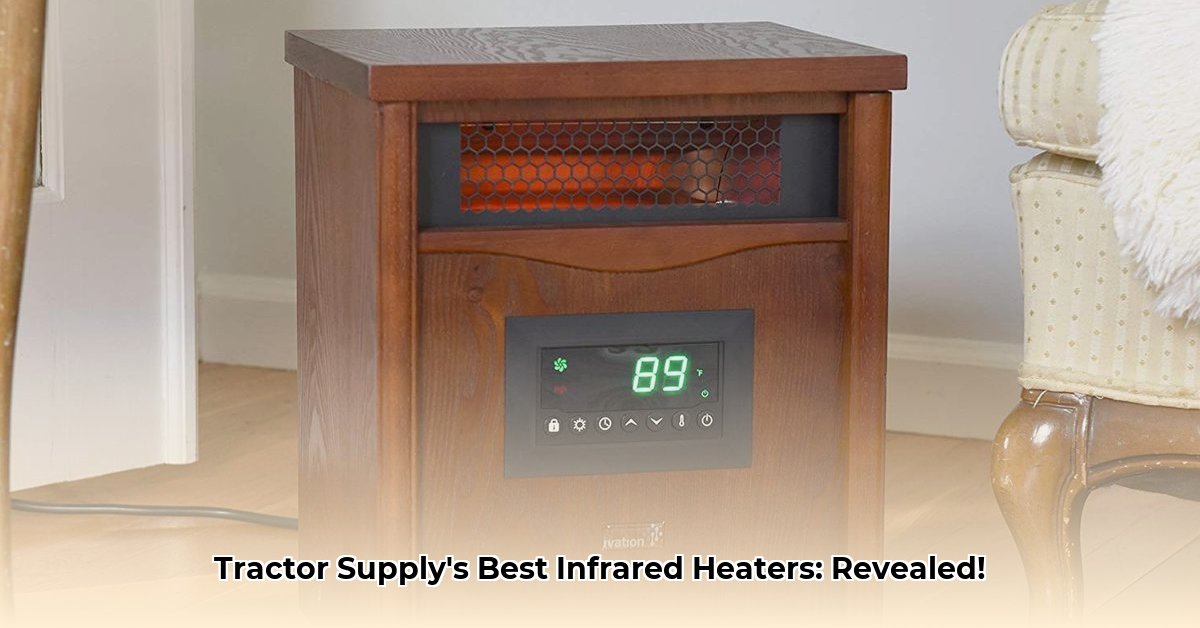
Understanding Infrared Heaters: A Simple Explanation
Thinking about warming up your barn, garage, or home this winter? Infrared heaters offer a targeted, efficient heating solution. Unlike traditional heaters that heat the air, infrared heaters directly warm objects and surfaces. This means less wasted energy and potentially lower bills. Imagine the sun warming your face – that's infrared radiation at work! This makes them a particularly attractive option for spaces that are already somewhat insulated. For more information on Tractor Supply's selection, check out their infrared heater options.
Choosing the Right Infrared Heater for Your Needs: Barn vs. Home
The perfect infrared heater depends heavily on your heating needs. A large barn requires a powerful heater with extensive coverage, while a smaller space needs a less intense unit. Here's what to consider:
Wattage (Watts): Higher wattage means more heat output, suitable for larger areas or extremely cold conditions. Think of it as the heater's "muscle." A higher wattage per square foot often suggests better energy efficiency, but always compare models.
Coverage Area (sq ft): Match the heater's coverage to the space you need to heat. Too small, and it won't be effective; too large, and you'll waste energy.
Mounting Options: Consider your space and preferences. Portable, wall-mounted, or ceiling-mounted options are readily available.
Energy Efficiency: Choose energy-efficient models to save money long-term. While not always explicitly expressed as a percentage, you get an idea of this by checking the ratio of wattage to coverage area. A higher wattage per square foot often suggests better efficiency.
Tractor Supply's Infrared Heater Options: A Comparative Guide
Tractor Supply offers various infrared heater models; make sure to check their current inventory for the latest offerings. The table below shows some example models (note that specifications and prices are subject to change):
| Model (Example) | Wattage (Watts) | Coverage Area (sq ft) | Mounting Options | Approximate Price ($) |
|---|---|---|---|---|
| ToughBuilt™ Heater A | 1500 | 500 | Floor-standing, wall-mounted | $150 |
| Heatwave™ Heater B | 3000 | 1000 | Ceiling-mounted, wall-mounted | $250 |
| CozyGlow™ Heater C | 2000 | 750 | Portable, wall-mounted | $200 |
(Note: These are sample models. Always check Tractor Supply's website for the most up-to-date information on available models, specifications, and pricing.)
Step-by-Step Installation Guide: Safety First!
Safe installation is crucial. Follow these steps:
Read the Manual: This is paramount. Each model has specific instructions.
Secure Mounting: Mount the heater according to the manufacturer's guidelines. A loose heater is extremely dangerous.
Electrical Check: Ensure your electrical system can handle the heater's wattage. Overloading a circuit is a fire hazard.
Proper Ventilation: Ensure adequate ventilation to prevent carbon monoxide buildup. Check the manufacturer's guidelines for ventilation needs.
Safe Placement: Keep the heater away from flammable materials.
Infrared Heaters: Weighing the Pros and Cons
Pros:
- Energy Efficiency: Targeted heating leads to less energy waste and lower operating costs.
- Focused Heat: Ideal for warming specific areas without heating the whole space.
- Fast Heating: Experience warmth almost instantly.
- Versatile Mounting: Choose from several mounting options to fit your space.
Cons:
- Line-of-Sight Required: Heat travels in straight lines; objects outside the direct range won't be as warm.
- Upfront Cost: Infrared heaters may have a higher initial purchase price than other heating options.
- Not Ideal for All Spaces: They might not be the best solution for extremely large, drafty, or poorly insulated areas.
Remember, consult a qualified electrician for any concerns about electrical work or installation. The right infrared heater from Tractor Supply can help maintain a cozy and comfortable environment for you and your animals.
Reducing Environmental Impact with Infrared Heaters
Infrared heaters, when powered by renewable energy sources, offer a more sustainable heating solution than traditional systems. Here's how to minimize their environmental impact:
Renewable Energy Source: Utilize renewable energy sources such as solar power to drastically reduce the carbon footprint.
Strategic Placement: Optimize heater positioning to avoid heating unnecessary areas.
Regular Maintenance: Maintain your heater to ensure optimal performance and prevent energy waste.
Energy Monitoring: Track your energy usage with smart meters to identify areas for improvement.
By choosing energy-efficient models and powering them with renewable energy, you can significantly reduce the environmental footprint of your heating system.